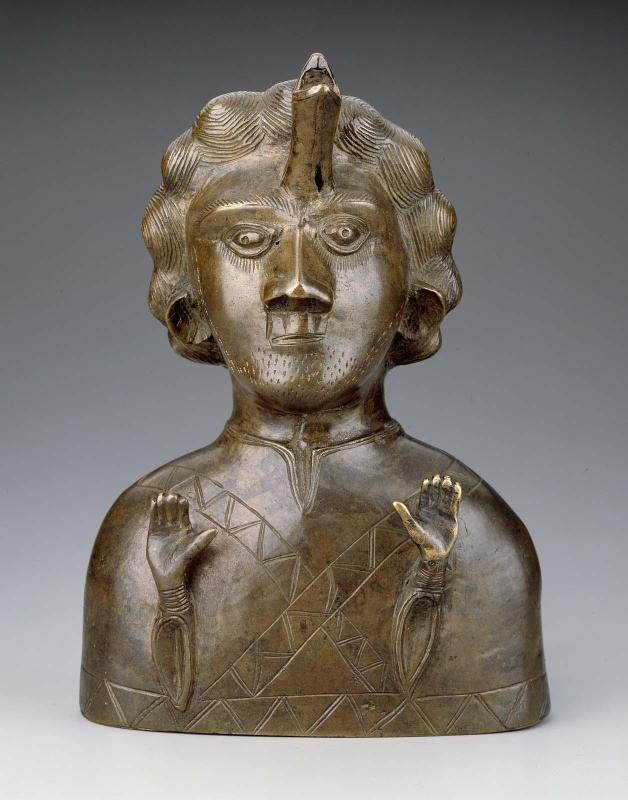Bust Aquamanile
late 12th–early 13th century
Object PlaceGermany
Medium/TechniqueLatten (83.6% copper, 7.2% zinc, 3.2% lead, 6% tin)
Dimensions24.1 x 17.6 x 18.1 cm (9 1/2 x 6 15/16 x 7 1/8 in.)
Credit LineDecorative Arts Special Fund
Accession number65.465
On View
Not on viewClassificationsMetalwork
Collections
Aquamaniles are vessels to hold the water used for washing hands. First used by priests during religious ceremonies, such vessels later appeared on the table in monasteries and noble households, and were produced in large numbers between the eleventh and fifteenth centuries. Here, the aquamanile is in the shape of the bust of a man, with the pouring spout an open-mother animal projecting from his forehead. Two small hands attached to the chest create an almost whimsical image of a figure bowing as the vessel is tipped to pour the water.
ProvenanceMichalkow, Ukraine. August Wolff, Heidelberg, Germany; November 5, 1931, posthumous Wolff sale, Helbing, Munich, lot 73, sold for 8500 M. 1935, art market [see note 1]. By 1956, Brummer Gallery, New York [see note 2]; 1965, sold by Ella Brummer to the MFA. (Accession Date: April 14, 1965)
NOTES:
[1] Otto van Falke and Erich Meyer, Romanische Leuchter und gefässe Giessgefässe der Gotik (Berlin, 1935), p. 109, no. 335, fig. 312. [2] The aquamanile was mentioned in a letter from Hanns Swarzenski of the MFA to Ernest Brummer of Brummer Gallery, New York (June 29, 1956) and was sold to the MFA by his wife, Mrs. Ella Brummer, in 1965.
NOTES:
[1] Otto van Falke and Erich Meyer, Romanische Leuchter und gefässe Giessgefässe der Gotik (Berlin, 1935), p. 109, no. 335, fig. 312. [2] The aquamanile was mentioned in a letter from Hanns Swarzenski of the MFA to Ernest Brummer of Brummer Gallery, New York (June 29, 1956) and was sold to the MFA by his wife, Mrs. Ella Brummer, in 1965.
19th–20th century
10th–11th century
13th–14th century
late 15th century (?)
5th–6th century
1600–25
late 14th–15th century
7th - 9th century
1400–1500
12th century–early 13th century
early 6th century (?)




